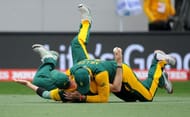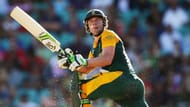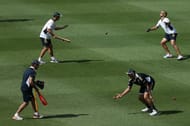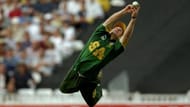Over the years, perhaps the most evolved factors in cricket have been fielding and fitness. While the game has swayed in the favour of the batsman, with big bats and flat pitches, batsmen have adapted to the new conditions and incorporated several innovations to the game.Similarly, bowlers have also done their part to ensure batsmen don’t have it too easy, using their wits to bring about their own inventions, which include the carrom ball and the slower-ball yorker. But the aspect of fielding still remains in the shadows.While Cricket has seen its fair share of amazing catches and moments of brilliance in the field, the first person who really intensified the importance of fielding was former South African cricketer Jonty Rhodes. With fast hands and faster reflexes in the field, Rhodes proved how crucial a run-out or a couple of good catches could drastically alter the result of a game.The best fielding unit in modern day cricket are undoubtedly the South African cricket team, with each and every player sweating it out in the field. From 20-year-old Kagiso Rabada to 32-year-old Hashim Amla, every single cricketer takes his fielding seriously. The concept of age and lethargy has no place in the Proteas side, with fielding being given top priority by their coaches. What exactly puts South African fielding on a higher level? These are some factors:
#1 Focus at the domestic level

The infallible logic is that when players are exposed to high levels of fielding while playing for their domestic sides; it becomes easy for them to adjust to it during the higher levels of the game, especially during pressure situations. The fact that the domestic cricket shows so much competition is a sign of how seriously the players take their fielding.
When players are encouraged to field their best from a young age, it becomes second nature for them by the time they are eligible to appear for the side, as evidenced by some of South Africa’s best fielders.
One of their under-rated fielders, Dale Steyn started his cricket career at the age of 11, where he played for the Northerns (who later merged with the Easterns to form the Titans) one of South Africa’s most prestigious cricket counties. There, he got the chance to play alongside South Africa’s best fielders of the day – AB De Villiers, who was also inducted into the game when they were schoolboys.
#2 Diverse range of sports played

Apart from the high levels of fielding drills conducted by the domestic sides, another major factor that contributed to South African players’ fitness is the diverse range of sports they play. Look no further than the greatest of them all, Jonty Rhodes himself, who was an accomplished hockey player.
His playing hockey definitely helped him move quicker on the cricket field, where the action is not as hectic. His razor-sharp reflexes are as much as a by-product of his time on the hockey field as of his intensive training.
Dale Steyn is into outdoor sports, which include deep-sea diving and skateboarding. This allows him to take a rest from cricket whenever he wants to, but keeps his body in shape. His love for outdoor activities keeps his fitness in check, which allows him to bowl longer, harder and faster, keeping his reserve energy in full flow.
Perhaps the best fielder in modern times, AB De Villiers is no stranger to playing different sports. Excelling at golf, tennis, swimming, badminton and rugby, De Villiers constantly seeks out new ideas to keep improving his fitness and staying ahead of the game.
The players also conduct football training sessions in between their regular cricket training periods, again to take their mind off the game without affecting their fitness. The encouragement given by the coaches at the domestic circuit goes a long way in shaping these cricketers for the future, and the experience they get from playing different sports helps them stay fit and focused, which are basically the things a good fielder must permanently possess.
#3 Drills and diet followed

Perhaps one of the unknown gems created by Cricket South Africa is the “Essential Cricket Drills”. It was produced by the CSA Coaching Department and it includes over 100 different training techniques that includes batting, bowling and especially fielding. With modern coaches preferring to coach by word-of-mouth, the CSA specializes in coaching from the manual, and it has given them terrific results.
The very idea of including fielding as an important trait in the game shows how much it is valued in the country. Rather than treating fielding as a third wheel, it is given equal importance as batting or bowling.
It is because of this that there are more and more incidents of fielding innovations such as the ‘hokey-pokey’ – where the fielder throws the ball into play while catching on the boundary – and how they make even the toughest, swirling catches look almost easy.
Their drills include separate training sessions for slip catching, attacking fielding, over-arm and under-arm throwing and high catching. It is compulsory for every player to participate in the fielding drills, and it is by this that several strategies are chalked out, including that of field placement and fielding roles. The latter is again an important factor of the game, as it decides the role of each fielder.
The faster bowlers usually prowl the boundaries at third man or fine leg, while the fit fielders field inside the thirty-yard circle. But South Africa has turned it around, with premier fast-bowler Dale Steyn often fielding at mid-off or mid-on, and fielders who are quick on their feet, such as AB De Villiers and David Miller fielding at the boundaries. It is due to these seemingly small innovations that South Africa has consistently improved as a fielding side.
Another important factor that keeps the Proteas fit is their diet. While this may not seem as crucial to their prowess as other factors, it must still be touched upon. Dale Steyn who can easily challenge fitness-machine AB De Villiers survives entirely on brown rice, chicken and tuna, combined with his daily protein shakes and energy drinks.
On the other hand, Faf Du Plessis focuses more on his stamina than body strength, and is happy to stick with oatmeal and salmon, which do not contain fat content. Tall and strapping fast bowler Morne Morkel recently adopted a vegan lifestyle, which he says has helped him regain lost fitness and does not make him prone to injuries. Cutting out fizzy drinks and sugar intake, Morkel admits that it his diet which has helped him clock longer hours in the field.
#4 The Jonty Effect

Fielding in international cricket took on a new dimension after the introduction of Jonty as he showed how good he was. He inspired several cricketers to take their fielding seriously, as more and more matches were turned by a moment of skill in the field – a quick run-out or a spectacular diving catch.
The main reason why Jonty was so good on the field was because he gave it all. In his words, ‘fielding isn’t work when you’re enjoying it’. There are incidents of Jonty coming late to the team bus because he spent those extra few minutes throwing down the wickets from ten metres or less and taking reflex catches near the stumps.
Jonty’s mindset was unique, as he preferred to go towards the ball rather than wait for the ball to come to him. He notes the fact that South Africa encourages boys to throw themselves around in the field at a very young age which helps them improve the fielding, and he has also commented that subcontinent teams do not do the same, which may be the reason for their relatively poor fielding.
Rhodes touched on the different types of training that he advised the players to do, which includes starting fast while going for the ball, which helps to cover more distance and stop balls that would have otherwise passed batsmen. He also spoke about how anticipation is a big part on the field, and that it could make or break a moment and turn a half-chance into a good one.
He also trained the team to watch the batsmen, as he believed it was important to read the batsman’s style to know what he is thinking. Another important thing to note is how the South Africans cut down the angle at which the ball is arriving by diving in front, which helps to smother unnatural spin or bounce.
The fielding maestro also mentioned the many mistakes the teams make when they try to up their ante, but at the same time noted that it is the mistakes which make them so good in the field. A major part of Jonty’s training regimen is juxtaposed with the player’s fitness, as he truly believed that the player must put in a dive without fear of injury.
#5 Emphasis on fielding given by coaches

The credit for the South African cricket team’s highly efficient fielding can go to their diet, their fielding drills or even to the presence of Jonty Rhodes, but another set of people also deserve equal credit – the coaches and support staff. From Russel Domingo as head coach to Paddy Upton as the mental conditioning coach, South Africa have never been found lacking in the coaching department.
When skilled players in the team are coached by experts in their field, it is not uncommon to see such high results. Head coach Russell Domingo never played much cricket, but he took to coaching very early in his life.
At just 22, he was appointed as the coach of the Warriors domestic team, where he trained players such as Johan Botha and Tyron Henderson in his first ever coaching stint. His coaching plan helped them win the 20-over and 40-over tournament in 2009-10, and his emphasis on fielding helped the Warriors make seven finals in five years.
The domestic teams in South Africa also take their fielding very seriously, as evidenced when Lance Klusener, coach of the Dolphins domestic team, called upon Ryan Maron, fielding consultant to the Afghanistan National Team to train the young cricketers.
With South Africa giving high importance to fielding, Klusener makes it his top priority to make the Dolphins the best fielding team in the country.
Apart from head coach Domingo, coaches Michael Hussey and Paddy Upton also have to be given equal credit. Hussey himself proved his fitness as he played competitive cricket till he was 38, and still continues to play in domestic T20 formats across the world. It is a testament to his fitness that he was chosen to mentor the South African team, which is the best in the world.
Paddy Upton, who previously worked with Indian cricket team, also helped in their rise in fielding circles. Upton has been strongly recommended by ex-coach Gary Kirsten, and the South African team’s fitness shows us why.
Credit must be given to Cricket South Africa’s policy of giving importance to fielding and fitness at the grass root level and imparting basic knowledge among the younger cricketers, which plays a big part in them becoming world class players.
